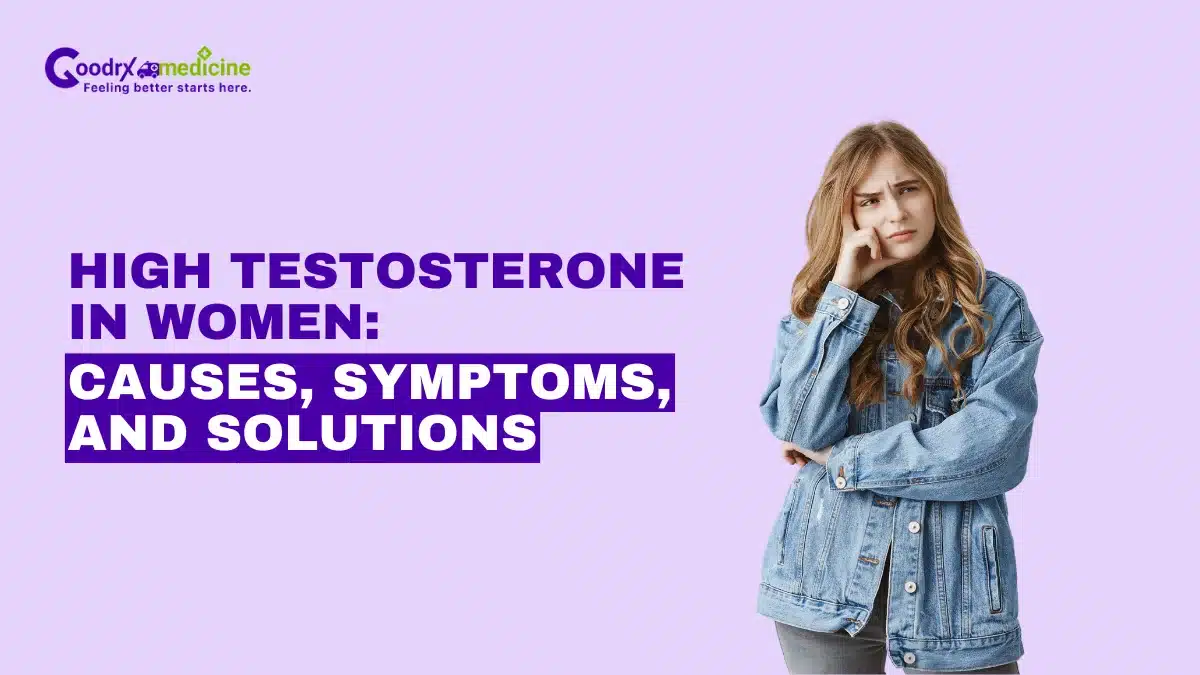Testosterone, though mainly a male hormone, plays an essential role in women’s health by supporting bone density, muscle mass, and sex drive. Sometimes, high Testosterone in women can occur due to hormonal imbalances, resulting in a condition known as Hyperandrogenism.
This increase can lead to various symptoms such as excess hair growth, acne, infertility, and weight gain. Knowing the signs of high Testosterone in women is good for maintaining physical and mental well-being.
While medications can help manage this condition, many seek natural treatment options to help women restore hormonal balance and improve their overall health. This article explores the causes, signs, and how to treat high Testosterone in a woman naturally through lifestyle and diet changes.
What is considered high Testosterone in women?
Testosterone is essential to women’s health by supporting libido, mood, bone mass, and blood cell production. The ovaries and adrenal glands release small amounts of this hormone, and its interaction with estrogen helps maintain and repair reproductive tissues.
When levels exceed the normal female range, the effects can disrupt both physical health and emotional well-being. Hyperandrogenism, or high Testosterone, may lead to symptoms such as acne, facial hair growth, excessive weight gain, low libido, and fertility issues.
While Testosterone levels in both men and women may naturally decline with age, an unexpected rise in women can cause health concerns. Unlike men, who typically have Testosterone levels between 280 and 1,100 ng/dL, women need far less for proper body function.
Normal Testosterone levels in women range from 15 to 70 nanograms per deciliter (ng/dL). Anything above this range is considered high Testosterone in women. A blood test can measure these levels.
Understanding what constitutes high Testosterone helps in early detection and management to prevent complications and maintain overall well-being.
Symptoms of high Testosterone in women
Women with high Testosterone levels may experience a range of physical and emotional changes. These symptoms of high Testosterone can vary from person to person, and not everyone will show the same signs. If you notice any of these symptoms, consult a doctor for proper diagnosis and treatment.
Common symptoms of high Testosterone in women include:
- Hirsutism (severe hair growth on the face or body)
- Acne
- Alopecia (hair thinning or balding)
- Irregular menstrual cycles
- Loss of libido
- Fertility problems
- Increased muscle mass
- Enlarged clitoris
- Deepening of the voice
- Mood swings
- Unexplained weight gain or obesity
Acne and excessive hair growth are two of the most visible and frequent signs of high Testosterone in women.
Causes of high Testosterone in women
Testosterone is an essential hormone for women, even though their bodies produce it in small amounts. However, certain conditions and factors can lead to unusually high levels. The causes of high Testosterone in women often stem from underlying health issues or hormonal imbalances.
Common causes of high Testosterone in women include:
- Polycystic Ovary Syndrome (PCOS): A common condition causing small cysts on the ovaries, irregular periods, and hormonal imbalances. PCOS increases insulin levels, which can stimulate the ovaries to produce more Testosterone. Many women in their reproductive years experience high Testosterone levels due to PCOS, with rates ranging from 5 to 26%.
- Congenital Adrenal Hyperplasia (CAH): A genetic disorder affecting the adrenal glands, leading to a shortage of enzymes needed to produce female hormones. This enzyme deficiency results in excess Testosterone production.
- Thyroid issues: Hypothyroidism (underactive thyroid) can reduce Sex Hormone-binding Globulin (SHBG) production, a protein that regulates hormone balance. Low SHBG levels allow free Testosterone to rise in the bloodstream.
- Insulin resistance: When your body resists insulin, blood sugar levels increase, prompting the ovaries to produce more Testosterone.
- Medications: Certain medicines like anabolic steroids, synthetic progestins, and antiepileptics can elevate Testosterone levels.
- Genetics: Some women naturally produce higher levels of Testosterone due to genetic factors.
If you suspect any of these causes, consult a doctor for proper testing and diagnosis.
Synthetic progestins: The medication is used for Hormone Replacement Therapy (HRT) in women, but may cause uterine changes.
Antiepileptics: The medicine helps prevent seizures.
Dihydrotestosterone (DHT): A more powerful form of Testosterone, primarily responsible for male characteristics and hair loss.
How to treat high Testosterone in women
Treating high Testosterone in women depends on the underlying cause and severity of symptoms. Doctors usually confirm high Testosterone through blood tests and may perform physical exams or ultrasounds, especially if they suspect conditions like PCOS.
Treatment often includes medications and natural remedies to restore hormonal balance. Always consult a doctor before beginning any treatment plan.
Medications
Doctors commonly prescribe medications to lower Testosterone levels, including:
- Spironolactone: An anti-androgen that reduces Testosterone production.
- Oral contraceptives: Containing low doses of progestins like Norgestimate, Desogestrel, or Gestodene, these help prevent excess Testosterone production.
- Metformin: Often used for insulin resistance, especially in PCOS cases, to improve hormonal balance.
- Glucocorticosteroids: Sometimes prescribed for select cases with adrenal involvement, like Congenital Adrenal Hyperplasia.
Natural remedies
Alongside medications, women can adopt natural approaches to manage high Testosterone:
- Maintain a healthy weight: Losing around 5 to 10% of body weight may improve fertility, normalize menstrual cycles, and reduce PCOS symptoms.
- Balanced diet: Reduce sugar and refined carbs to lower insulin levels; increase fiber, healthy fats, vegetables, fruits, nuts, and seeds to support hormone balance. Focus on healthy fats and anti-androgenic foods like flaxseeds and licorice root.
- Supplements: Herbal options like saw palmetto and spearmint tea may help reduce Testosterone effects, though more research is needed.
- Regular exercise and proper sleep: These support overall hormonal health and reduce stress. Stress management and sleep are essential for hormone regulation and overall health.
Conclusion
High Testosterone in women occurs when levels exceed the normal range of 15 to 70 ng/dL, potentially disrupting physical and emotional health. Identifying the signs of high Testosterone in women, such as excess hair growth, acne, irregular periods, and fertility issues, is vital for early diagnosis and management.
Common causes include Polycystic Ovary Syndrome (PCOS), congenital adrenal hyperplasia, thyroid problems, insulin resistance, certain medications, and genetics. Proper diagnosis often involves blood tests and physical examinations.
To treat high Testosterone in a woman naturally, adopting lifestyle modifications, such as eating a balanced diet, exercising, reducing sugar, managing weight, and getting enough sleep, can make a big difference.
Alongside these natural remedies, doctors may prescribe medications such as Spironolactone, oral contraceptives, and Metformin to address underlying causes and reduce Testosterone levels. If you notice any symptoms, don’t ignore them. Early action helps protect your health and well-being.

Frequently Asked Questions
Is high Testosterone in women always PCOS?
No, high Testosterone levels in women are not always caused by Polycystic Ovary Syndrome (PCOS). PCOS is the most common cause of high Testosterone in women, but other factors can also lead to the problem.
When is Testosterone highest in females?
Testosterone is highest in females during their early adult years, usually between 20 and 30. It helps with energy, mood, and muscle strength. After this time, Testosterone levels slowly go down as you get older, but it still plays a vital role in your body.
Is low Testosterone a concerning problem for women?
Yes, u003ca href=u0022https://www.goodrxmedicine.com/blog/sexual-wellness/low-testosterone/u0022u003elow Testosteroneu003c/au003e in women can be concerning as it may lead to fatigue, reduced libido, depression, and weakened bones. Testosterone levels should neither be low nor high in women for overall health.
How does high Testosterone in women affect them emotionally?
High Testosterone in women can affect their emotions in many ways. They might feel mood swings, irritability, or feel sad without a clear reason. It can also cause stress and anxiety. These emotional changes happen because hormones affect how their brain works.
When referencing outside resources, GoodrxMedicine always provides full citations. To learn more about the measures we use to maintain the quality of our content, please review our Content Information Policy.















